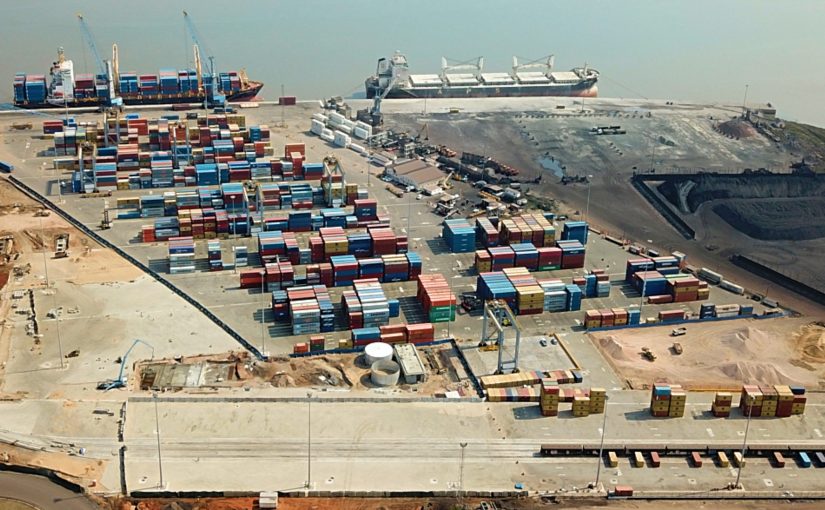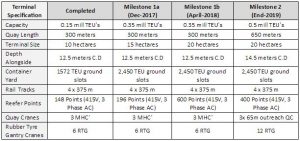Mozambique: Issuing of licenses for alcoholic drinks suspended- AIM report
DP World Maputo laying the long-term foundation for million TEU Container Terminal

Courtesy photo of DP World Maputo
Maputo is set to regain its status as a major container port thanks to a combination of investments in the approach channel, the container terminal operated by DP World and the landside logistics chain. “Our target is to ramp up capacity to a million TEU per annum, steadily over the next few years” says Tejas Nataraj, CEO at DP World Maputo.
To provide the trade with another gateway option we are in the process of developing the capability to handle mainline vessels that will connect the regional hinterland to markets in the Far East/China, East coast of USA, Mediterranean and North Europe and the Middle East. To support these strings, we are also planning on regular feeders to all the major ports on the East and West coast of Africa. All this will be made possible by a substantial investment in all the infrastructure, equipment and systems of the terminal.
Recent investments by DP World include the refurbishment of 15 hectares of yard, the addition of 1,5 kilometres of rail siding and the introduction of rubber-tyred gantry cranes, which have already improved productivity. The investment in rail will help exporters and importers reduce logistics costs and avoid delays at border crossing. By the end of the year the terminal capacity will have more than doubled from 150 000 TEU to 350 000 TEU.
In addition to the physical infrastructure DP World is upgrading its Terminal Operating System (TOS), to replace all physical paperwork with electronic processing. This will substantially cut down processing time and delays, while dramatically improving the safety and security of the terminal´s employees, visitors and cargo.
Infrastructure Development Timeline

The outdated historical perception of Maputo being a costly and difficult logistical challenge and the traditional logistics practice of “That’s the way it´s always been done” does hinder the adoption of the Maputo corridor as a clear viable shipping option. But this is rather seen as an opportunity than a handicap, now that the terminal´s infrastructure has been developed to support trade, cargo owners/shippers can now benefit from; a geographically superior option and a terminal operator who is eager to actively collaborate with supply chain players in order to develop trade. The opportunities from the Maputo-Southern Africa Corridor are abundant for all, but it takes that initial momentum to bring about substantial change, where DP World Maputo has already seen the exponential increase in interest from cross border for the ability of Maputo to provide the long awaited alternate option.
Ease of Doing Business
Tejas is confident that perceptions can be changed, and that Maputo will be able to establish itself as a viable gateway for Gauteng, Mpumalanga and Limpopo. “The challenges facing the movement of containerised cargo via Maputo to and from the hinterland are not much different to those that were faced when Maputo was first promoted as gateway for bulk mineral exports. “It took determination, and time, for all the players to see the benefits that Maputo offers, but now Maputo Port´s bulk mineral export is a great success story, with cargo owners and shippers reaping the rewards of a superior export link,” he says.
DP World aiming for sweet spot
DP World Maputo will have 400 reefer plugs by the next citrus season as part of its drive to bring citrus exports back to the port. DP World sees Maputo as the ideal gateway for the export of citrus from the Mpumalanga and Limpopo regions of South Africa, and has committed to providing the infrastructure to support this trade by upgrading its reefer capacity to 600 plugs by April 2018.
“Maputo is the natural geographical port to serve the citrus industry in Mpumalanga and Limpopo,” says Tejas Nataraj, CEO at DP World Maputo. “Our first step was to build the physical capacity to handle citrus by road, rail and in the port.
Value-added logistics in the port of Maputo
Volumes of cargo moving through the Maputo Intermodal Container Depot (MICD) have started growing following a tailored customer solution approach by MICD. The facility, which is located 1.5 km from the container terminal within the Port of Maputo, is being used for container stuffing and destuffing, as well as short-term storage. Minerals delivered in bulk to the terminal are packed into containers.
A shuttle service then takes the containers to the nearby stack, without leaving the port precinct. “MICD complements the services offered by the DP World Container Terminal. “It can handle 200 000 tons of mineral products a year in outside storage and loading areas, as well as 200 000 tons of general cargo in a 8 500 square metre covered warehouse. Another advantage of the terminal is that it also operates as a depot for empty containers, which means there is sufficient inventory on hand for the loading of minerals and other cargo.
The terminal has achieved a steady rise in containerised mineral exports via Maputo during 2017 and is seeking to further facilitate this commodity´s exportation. Through its partnership with MICD, who is able to pack 200k MT/year of minerals within the port area, DP World Maputo is perfectly positioned to stimulate the trade route as a superior link to the East.
Maputo on logistics map
Investments in the Maputo port infrastructure and the container terminal have created “massive opportunities” for logistics companies and importers and exporters in the region it serves, says Tejas Nataraj, CEO of DP World Maputo.
“Our strategy is to change the landscape of Southern Africa shipping to the benefit of all. “The vision is for Maputo to become the shipping hub for the region, providing shorter logistical connections and lower total supply chain costs,” he says. Following the dredging of the approach channel and basins and the upgrading of the container terminal the next step in the realisation of this vision is the development of a “logistics ecosystem” which includes warehousing, trucking, depots, distribution centres and cold storage as the next step in the process.
“This ecosystem and its development will not only benefit the people of Southern Africa by helping to lower the cost of goods by reducing the total logistical cost, but it will also create thousands of jobs through many affiliated business opportunities. “This is greatly important for the economic development of the Southern African region, as the population should not have to bear the cost of inefficiency which is primarily due to a lack of competitive alternatives,” he says.
“The terminal has been redesigned and continues to expand, to not only accommodate the immediate market of Mozambique, but to also offer a much-needed alternative for the greater hinterland market of Southern Africa (South Africa, Swaziland, Zimbabwe, Zambia and Botswana),” he says. The investments by DP World Maputo and the Maputo Port Development Company give importers and exporters their first “truly competitive” supply chain options in a long time, he believes.












Leave a Reply
Be the First to Comment!
You must be logged in to post a comment.
You must be logged in to post a comment.